Padua is one of the most historical cities in Northern Italy and it’s known as a cultural and academic cradle.
Often dubbed the cultured neighbor of Venice, the city is famous worldwide for the University of Padua which, founded in 1222, is one of the oldest in all of Europe, and second in Italy after the University of Bologna (my city!)
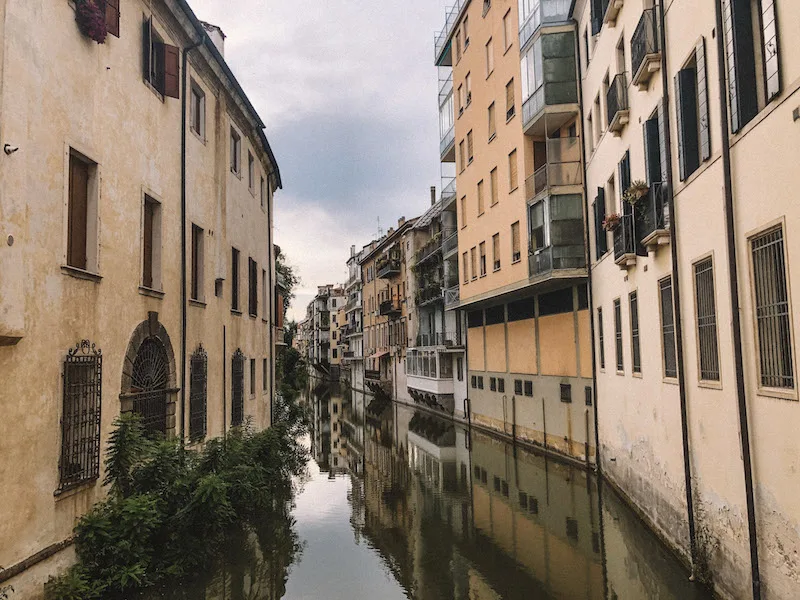
Padua is also home to the world’s most ancient botanical garden, considered the birthplace of botanical science and horticulture.
The city might be small, but there are plenty of amazing attractions to explore! Its numerous attractions range from museums, art galleries, and libraries to beautiful parks, important religious buildings, and astounding architecture.
While it’s not as famous as nearby Venice and Verona, Padua is a destination worth visiting, and it makes for a lovely weekend escapade.
In this guide, you’ll find everything you need to know, from when to visit to how to get there, the best things to do, and the traditional dishes you shouldn’t miss out on, so you can plan the perfect trip.
Why trust the recommendations in this guide to Padua? While I may not be the expert, my family certainly is! With all of my cousins, uncles, and aunts calling Padua their home, I’ve sourced authentic local tips and insights directly from them. Dive into this guide and discover Padua through the eyes of its true locals. It’s as close to firsthand experience as you can get without living there yourself.
Table of Contents
REASONS TO VISIT PADUA, ITALY
1. Historical city full of art
Padua claims the title of the oldest city in Northern Italy and is believed to have been founded around 1200 BC, boasting an incredibly rich history.
Its religious and art heritage, both of which are centuries old, is one of the major attractions in Padua, which has not only been an important pilgrimage site since the 1300s but also a cradle for the arts and culture.
The magnificent 14th-century frescoes of Scrovegni Chapel are often credited with sparking the Italian Renaissance, and the contemporary art scene in Padua is as thriving as ever, with frequent exhibitions and plenty of museums.
The well-preserved Medieval and Renaissance architecture, which offers a bridge to the past, is yet another Padovian gem that attests to the city’s artistic value.
2. Aperol Spritz was born here!
Beloved both in Italy and abroad, Aperol Spritz is one of the most celebrated Aperitivo drinks, and it originated in the very city of Padua in 1919.
Brothers Luigi and Silvio Barbieri, whose father owned a liqueur company, experimented for seven years to craft the Aperol drink, which was an immediate hit in Padua and its nearby cities.
It wasn’t until around the 1950s that Prosecco was introduced to the mix, and the recipe has remained unchanged ever since.
3. Great day trips from here
Padua is located in the heart of the Veneto region, and it’s well connected to the enchanting cities of Venice, Verona, Milan, and Vicenza to name a few.
It’s also close to the Euganean Hills, a wonderful area to visit for wine tasting, and by the Brenta River, so it’s an amazing base to go on memorable day trips around the region.
HOW TO GET TO PADUA
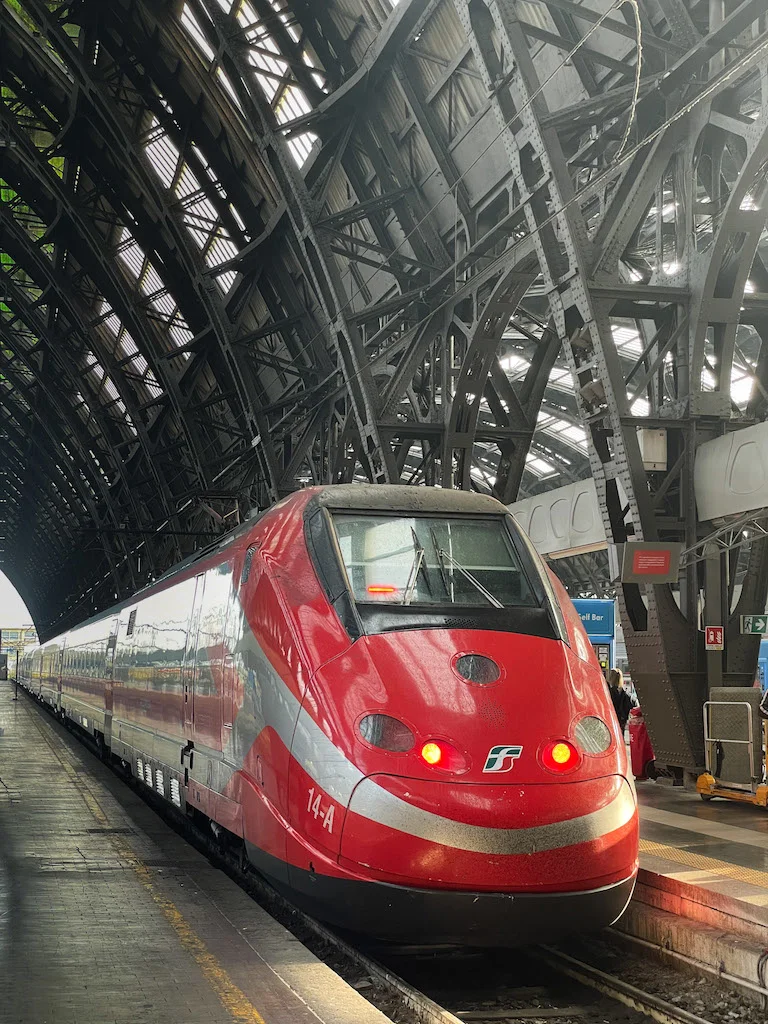
▶️ The best way to get to the city is by train. The train station in Padua is within walking distance of its main sights, and most Northern Italian cities – and the rest of the country, for that matter – have frequent services that pass through it.
The journey from Milan to Venice has its main stop in Padua, which also connects with most towns in the Veneto region by train.
Stazione Centrale di Padova (Padua Central Railway Station) is where you’ll be heading. To get your train tickets, you can either make a purchase online or get them directly at the station.
▶️ If you decide to start your visit to Italy in the Veneto region, the closest international airport to Padua is Venice Marco Polo Airport.
WHAT TO DO IN PADUA
I’ve previously written a full post about the very best things to do in Padua. However, if you’re in a rush, here below you’ll find our top recommendations. Check them out!
Go on a Walking Tour
The best way of getting around Padua to admire its squares, architecture, and picturesque corners is by putting on comfortable shoes and going on a walking tour.
This will give you a chance to stroll along charming alleys and major avenues, discover hidden gems, and make as many stops as you want to take in the vibrant atmosphere.
The number one place to go wandering around is the city center, also known as the university town, where the seat of the university, Palazzo Bo, is located.
Here you’ll also find the Cathedral at Piazza Duomo, and the beautiful Baptistery, among many other landmarks. It’s undoubtedly one of the best places to visit in the city.
You can also join a guided tour of Padua to gain a deeper understanding of its history and culture.
➤ This Private City Walking Tour & Scrovegni’s Chapel Visit is led by a certified guide who knows the city and its history like the palm of their hand. They’ll take you and your group around the historic center while recounting interesting tales about Padua. You’ll visit the Cathedral, Erbe Square, and access the awe-inspiring Scrovegni Chapel. ➥ BOOK IT HERE
➤ The Live Padua as a Local is a half-day tour that allows you to discover the most authentic side of the city, as you’re guided by a local. You’ll visit the country’s largest square, the Jewish Ghetto, and Piazza delle Erbe, all the while learning about the city’s history and culture. Finish the trip at Caffè Pedrocchi for a traditional tasting. ➥ BOOK IT HERE
Marvel at the Frescoes of Scrovegni Chapel
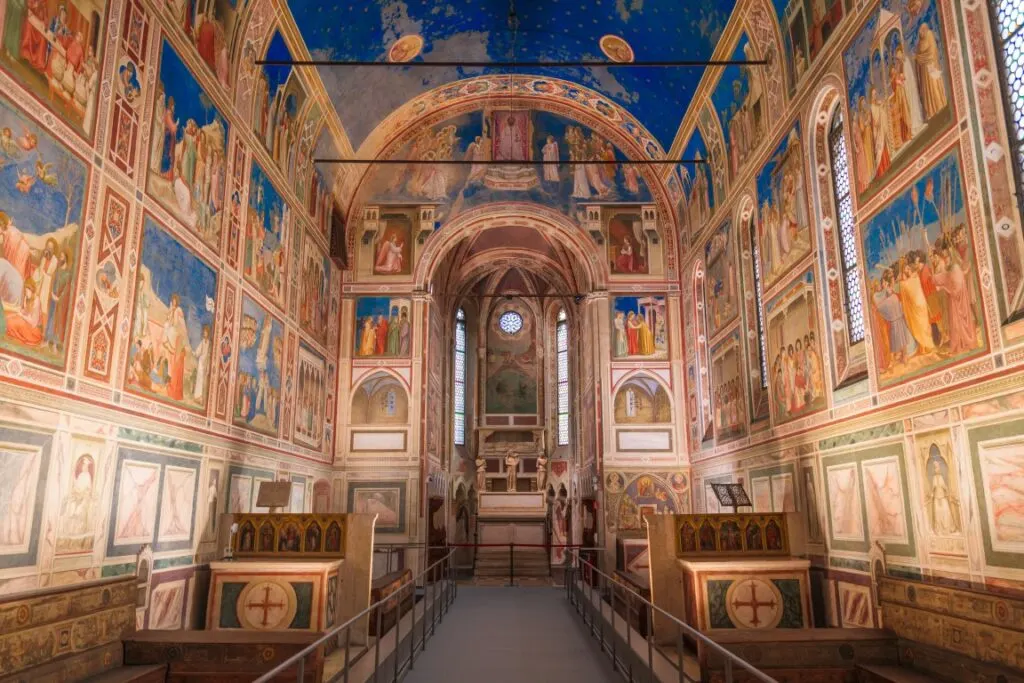
Among the most important things to see in Padua is Capella degli Scrovegni, a small and beautiful chapel built in the early 1300s. The chapel’s interior is completely covered in frescoes painted by Giotto di Bandone, which are said to have kindled the Italian Renaissance.
The paintings, which depict the life of Jesus and the Virgin Mary through numerous biblical scenes, date back to the 14th century and are well-preserved thanks to the careful monitoring of the chapel’s temperature and by limiting the number of daily visitors.
Tickets need to be booked in advance through the official website, and cost 15€ + 1€ presale fee.
Visit the Botanical Garden of Padua
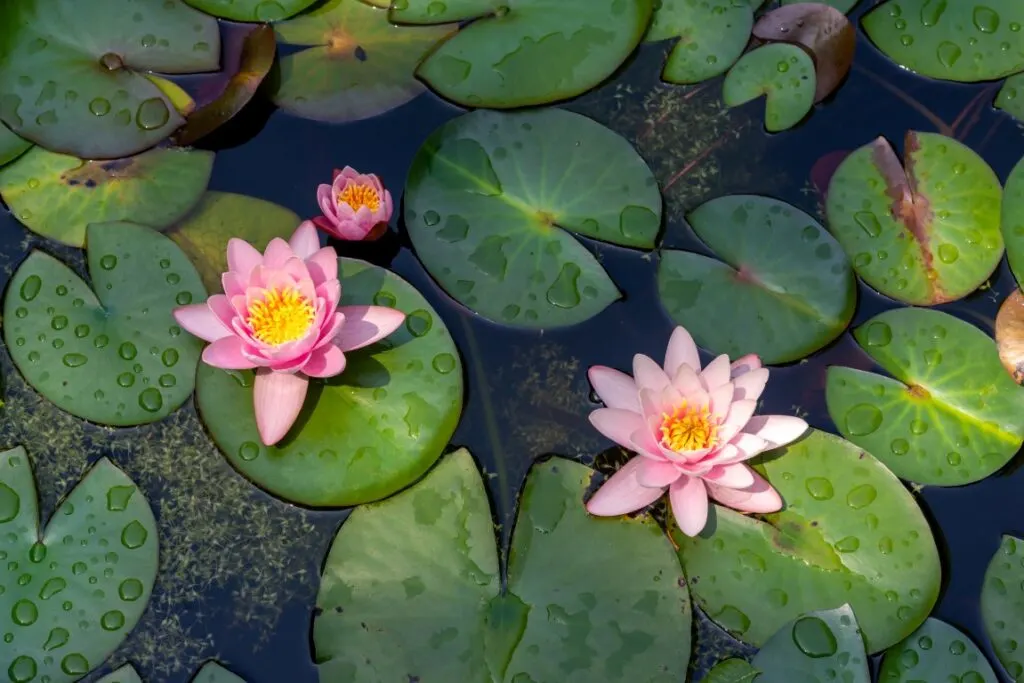
Did you know the Orto Botanico di Padova, which is a UNESCO World Heritage Site, is the first Botanical Garden in the world?
This 236,000-square-foot (22,000-square-meter) garden, which is still in its original location, was founded in the 16th century, and as part of the university it’s used for medical, botanical, and other scientific studies.
The garden houses over seven thousand species, and it’s located right next to the Basilica of St Anthony of Padua, so you could combine both visits.
Have Coffee at Caffè Pedrocchi

The most ancient café in Padua, which has been standing since the early 18th century, is Caffè Pedrocchi.
This iconic location serves one of Italy’s most famous coffee, offering all the classics, a few signature coffee-based drinks, and mouthwatering pastries (if you’re a sweet lover you absolutely can’t skip it).
The dining rooms are elegant and classy, and it’s a real treat to sit for a cup of coffee in such a fancy setting.
Piazza delle Erbe
Piazza delle Erbe is the former market square of the city, and it still holds a weekly market where you can buy fresh produce, handicrafts, and accessories.
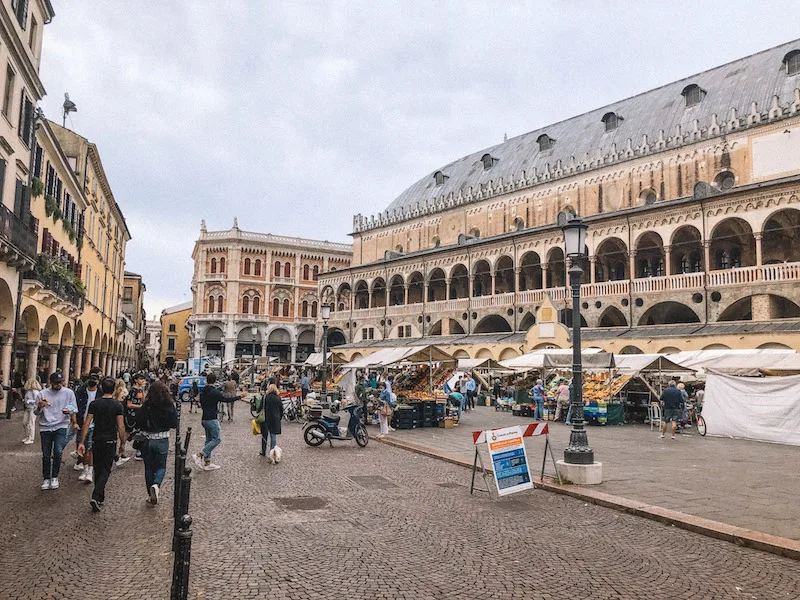
It used to be Padua’s beating heart back in the day, and while the reasons for its importance have shifted, it continues to be a focal point in the city, and a meeting spot for locals and tourists.
The square is surrounded by beautiful buildings and busy eateries and cafés, offering a wonderful excuse to take a break from your explorations and sit down for a while to people-watch with some nibbles or a glass of Aperol Spritz.
Check Out Prato della Valle
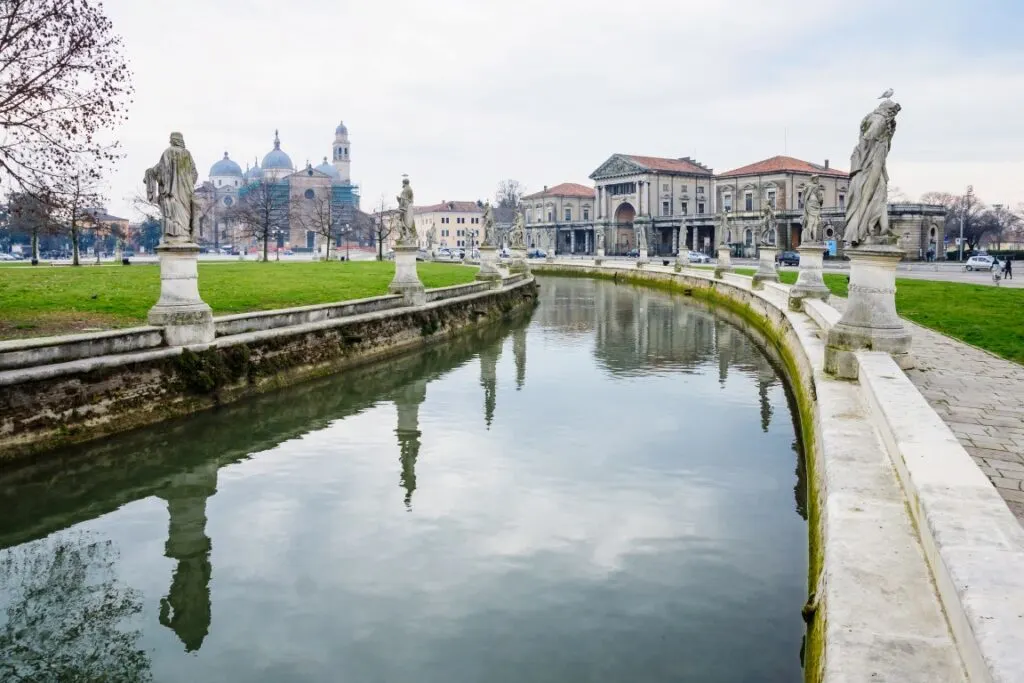
Padua is a city with numerous important locations, and the list has room for one more attraction: the largest piazza in Italy, Prato della Valle.
This very aesthetic square, which covers over a million square feet, has an elliptical shape with a green island in the center that’s encircled by a lovely canal. The piazza boasts 78 statues around it, rings of walkways, and four avenues: it’s a striking sight to behold!
WHERE TO EAT IN PADUA
▶️ Ristorante Boccadoro is an elegant Michelin-starred restaurant that specializes in Italian fare. It’s a great place to indulge in the traditional dishes of the region, such as Fegato alla Veneziana, Polenta alla Brace, and Bigoli al Baccalà, as it pays homage to Veneto’s cuisine. The setting is enchanting, the service is top-notch, and the food is absolutely delicious.
▶️ Enotavola Pino is yet another Michelin-starred eatery in Padua. This local spot specializes in pasta and seafood dishes and boasts an incredible wine menu. It’s both a restaurant and a bar, featuring wood-barrel tables that give it an atmospheric vibe. The restaurant, which is as popular among locals as it is with tourists, offers indoor and outdoor seating areas.
▶️ All’Ombra della Piazza is the place to be during aperitivo time, as it’s where you’ll find the most delicious Cicchetti in Padua. The Venetian-style tapas are the star of the restaurant, but you can also order tasty pizzas and other small bites to go with your Aperol Spritz.
ONE DAY IN PADUA ITINERARY
Visiting Padova, Italy in a single day? With this itinerary, you’ll be able to check out its main sights in the most efficient way. Your first stop will be Prato della Valle, the city’s most famous square.
Take snaps from every angle and stroll leisurely around it before making your way to Padua’s Botanical Garden. You could spend hours in the massive gardens, especially if you’re a botanical enthusiast, so be mindful of your time!
Next up is the Basilica of Saint Anthony of Padua (Basilica di Sant’Antonio), where the saint’s remains are housed. The building has been a pilgrimage site for centuries but is also worth admiring for its beautiful art and architecture.
After your visit, it’s time to check out the charming squares of the cities. Piazza delle Erbe is the closest to the Basilica, and it’s a perfect spot for taking a break to eat, have a cup of coffee, and people-watch.
A few steps away is Piazza dei Signori, named after the rulers who worked and lived around it. It’s also where you’ll find the impressive Astronomical Clock of the city!
Right next to the square, you can’t miss Palazzo della Ragione, likely one of the prettiest buildings in town. Divided into two floors, the upper one used to house the town hall while the ground floor is where the city’s market hall was located.
Admire the frescoes in the main hall, and then continue to Cappella degli Scrovegni.
Scrovegni Chapel will delight art lovers with the spectacular frescoes it boasts. You’ll need to purchase your tickets in advance to ensure access on the day of your visit!
Alternatively, you can start the day with a Padua: Private City Walking Tour & Scrovegni’s Chapel Visit, which lasts two hours and will give you a perfect introduction to the city.
BEST DAY TRIPS FROM PADUA
If you’re visiting Padua for a day, you should focus on the city’s major attractions. If you have more time, however, I recommend taking a day trip to Venice, the nearby wine country, or going on a cruise to take in the region’s beautiful scenery.
There are many places you can explore from Padua, and below you’ll find my top recommendations.
Embark on a Wine Tour
Veneto is one of the major wine regions in the country, which makes Padua a fantastic starting point to explore the area’s vineyards and wineries for sips of Veneto wine.
➤ This 8-Hour Prosecco Wine and Tastings Tour from Venice or Padua takes you to two wineries in the Prosecco DOCG area. You’ll meet the producers and learn about the history and making of sparkling wine, besides indulging in a tasting of four types of Prosecco. Cap off the day with lunch at a trattoria. ➥ BOOK IT HERE
➤ The Amarone Wine Tour & Tasting from Venice, Padua, or Verona is a full-day trip into the Valpolicella Valley, nestled between Verona and Lake Garda. You’ll stroll through historic vineyards and learn about the region’s winemaking techniques before tasting Amarone and Recioto wines paired with cheese. You’ll also be treated to a traditional lunch. ➥ BOOK IT HERE
Take a cruise along the Brenta River
The Brenta River, one of the most important ones in Northern Italy, played a great role in the history of Padua. It was used for the transportation of people and goods, and it connects Padua with Venice, which is why taking a cruise between the two cities is both a very enjoyable activity and a practical way to visit the city of canals!
As you glide down the river, following the route of the Venetian merchants, you’ll pass by opulent villas with striking architecture, so keep your eyes peeled!
➤ On this Full-Day Padua to Venice Burchiello Brenta Riviera Boat Cruise, you’ll hop aboard a Burchiello boat and set sail along the famous river. You’ll learn from your guide’s live commentary, and tour four different – and stunning – villas along the way. You’ll also stop in the town of Oriego to have lunch at a famous restaurant, and finish the tour in Venice. ➥ BOOK IT HERE
Venice
Venice is one of the most enchanting Italian cities, and being merely 28 miles (46 km) from Padua it’d be a crime not to visit! Known as the floating city, Venice is worldwide famous for its beautiful canals, but there’s so much more to it than the waterways.
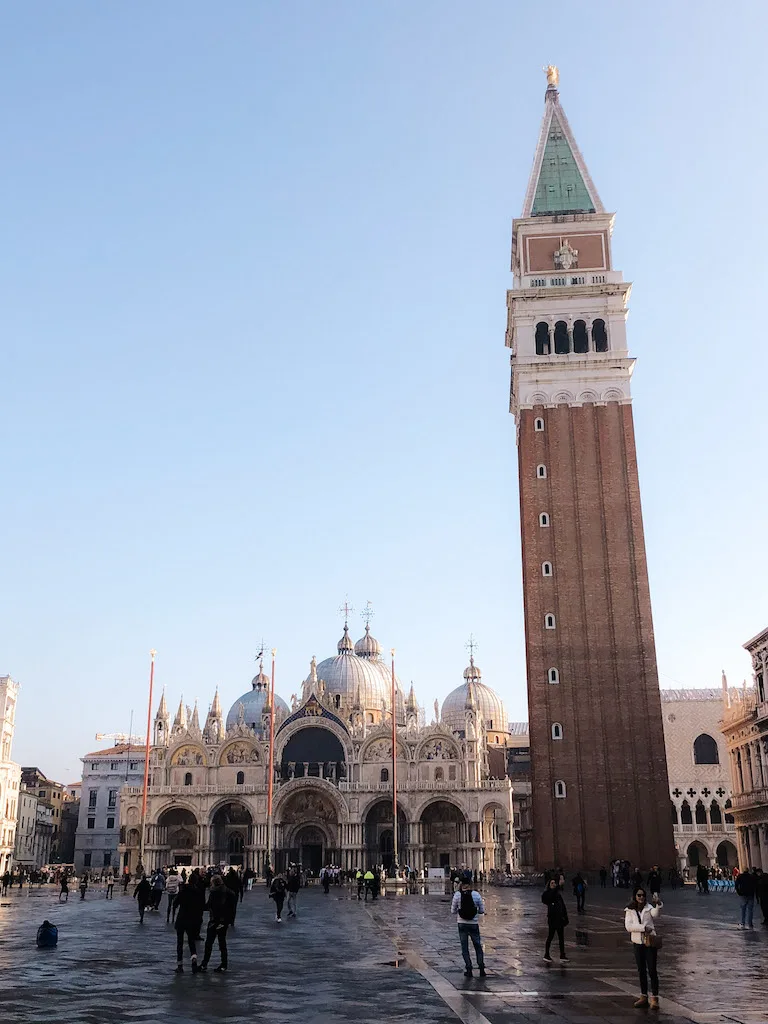
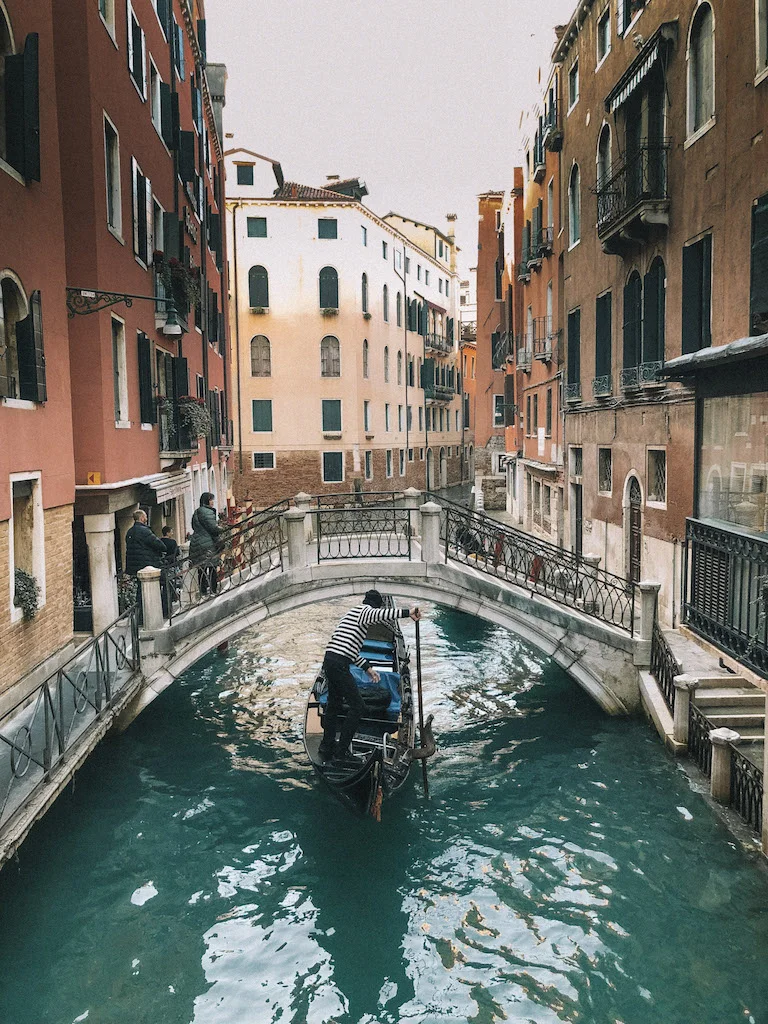
The architecture of the city is remarkable, and its history is equal parts eerie and fascinating. You can’t miss the ghost tours if you’re into spooky things!
The local food is mouthwatering, especially the Cicchetti, and the nearby islands of Murano and Burano are worth a trip if you have the time.
To get there you simply need to make your way to Padua Central Railway Station, and take a train to Stazione di Venezia Santa Lucia. The trip takes 30 minutes on the high-speed train, and tickets cost less than 5€.
To return, the train from Venice to Padua takes around the same time, so it’s the best way to make the journey.
➤ Alternatively, you can join this Live Venice as a Local departing from Padua. You’ll learn about Venice’s history while strolling around the Cannaregio district and the Jewish Ghetto, and admire the major landmarks from up close. You’ll also receive insider tips on where to have lunch and which café serves the best espresso. ➥ BOOK IT HERE
Euganean Hills
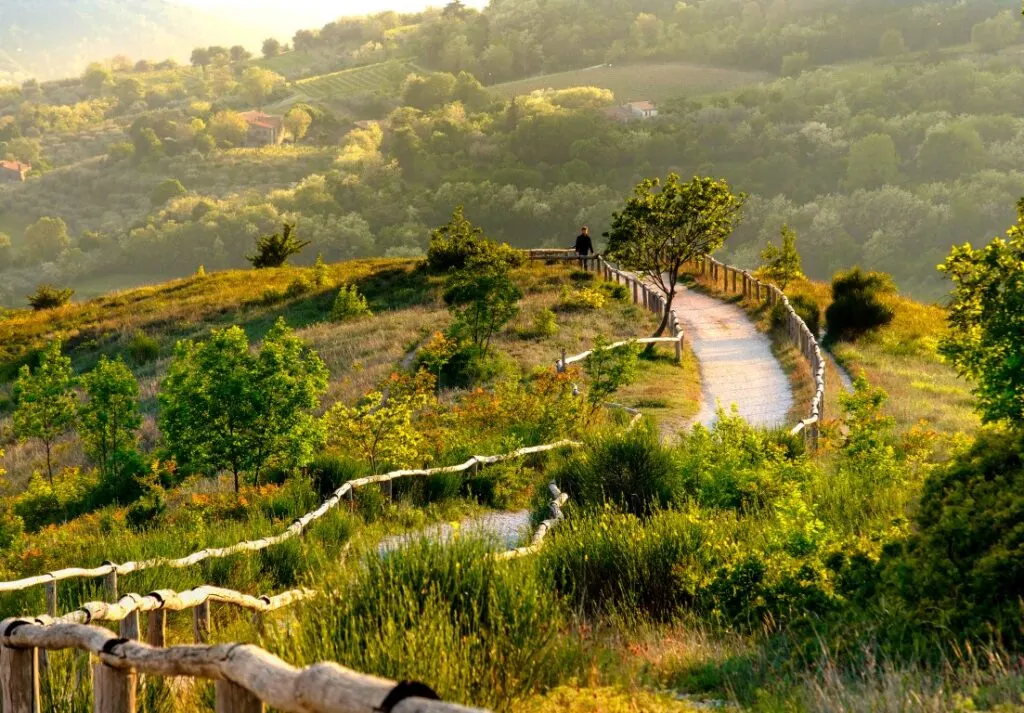
The Euganean Hills, or Colli Euganei in Italian, is a beautiful area of Veneto known for its wine and volcanic hills, which date back to over 30 million years ago.
It’s one of the most scenic natural locations close to Padua, and home to a few castles, so it makes for a very fun day trip!
The Euganean Hills is a vast area comprising villages that are far and few in between, so traveling there by public transportation is not very practical.
From Padua, you could take the train to Abano Terme, one of the major towns, but you’ll then find it hard to get around. For this reason, unless you have a car, I suggest joining a tour.
➤ From Padua to Arquà Petrarca, the Medieval Village is a half-day guided tour that takes you to the beautiful village of Arquà Petrarca. You’ll visit the poet Petrarca’s house, an olive oil mill, and a producer of Venetian delicacies for a tasting. ➥ BOOK IT HERE
➤ From Padua: Olive Oil & Wine in the Euganean Hills is a foodie’s top choice when it comes to Colli Euganei tours. You’ll visit a local olive oil mill to learn about its production and enjoy a tasting, and then head to a winery for a cellar tour and to sample typical wines. ➥ BOOK IT HERE
Verona & Lake Garda
Verona and Lake Garda combined are the perfect recipe for a dream day trip – they’re two of the most alluring locations in Northern Italy, and make for an enchanting escapade.
Verona is considered the city of love for being the setting of Romeo and Juliet, but its charm is entirely its own merit, featuring beautiful architecture, remains of the great Roman Empire, and a beautiful river.
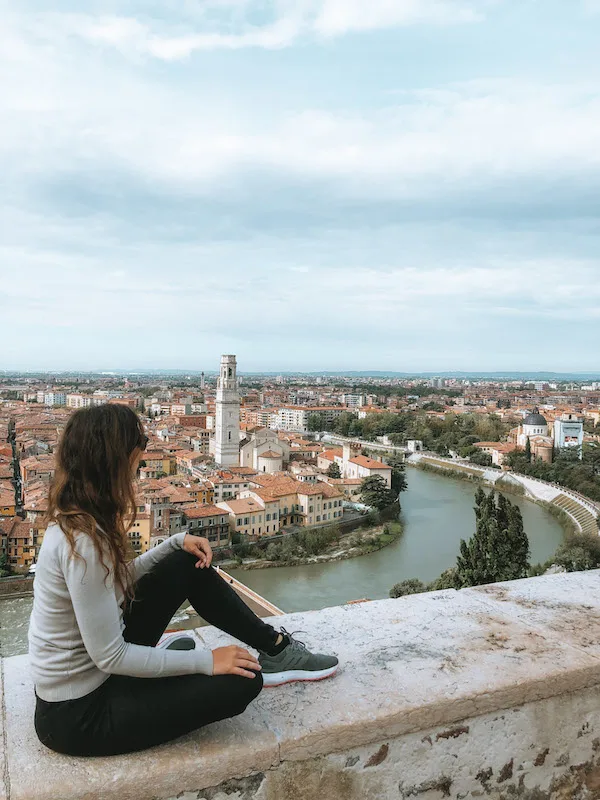
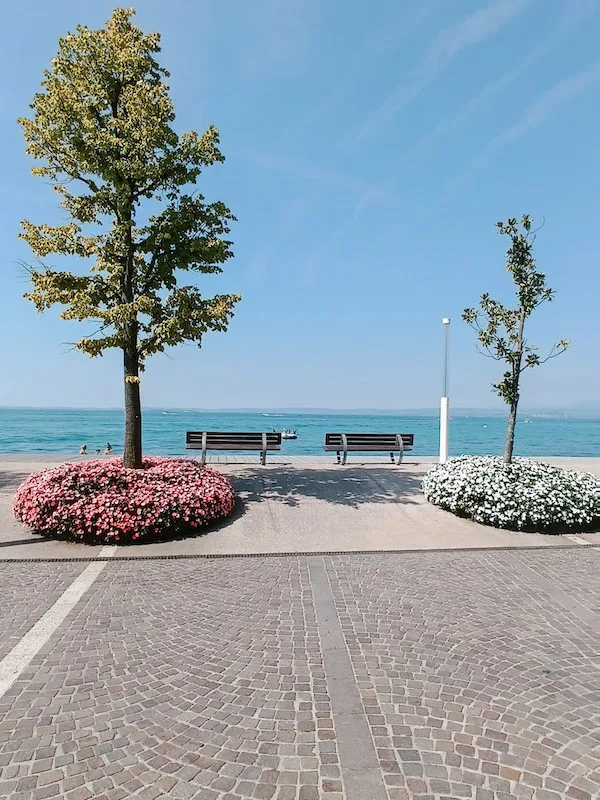
Lago di Garda is the largest lake in Italy, and it’s one of the most sought-after destinations for holidaymakers. The lake is surrounded by beautiful towns that showcase a rich culture, architecture, and cuisine, plus exceptional views that won’t let you put your camera down.
Sirmione, Lake Garda’s most popular town, and Verona are 25 miles (40 km) away, and they’re 79 miles (128 km) and 59 miles (95 km) from Padua respectively.
You can travel between the cities by the fast regional train, making the journey to Sirmione, which takes a little over an hour, then connecting to Verona. When you’re ready to return, take the train from Verona to Padua.
You can check the train times ahead of time to plan your day, or else join a tour from Padua.
➤ This Full Day Guided Tour of Verona and Garda Lake starts with a scenic drive to Verona, where you’ll enjoy a walking tour around the city with a professional guide. You can opt to take the funicular up to San Pietro Hill, and after a lunch break make your way to Garda. There you’ll explore the town of Sirmione, known as the Pearl of Lake Garda. ➥ BOOK IT HERE
Vicenza
Lesser known than its neighbors Treviso, Venice and Verona, Vicenza is a gem in the Veneto region that’s worth checking out. One of the major attractions in Vicenza is its architecture, as the city could be considered the personal project of the famous Renaissance architect Andrea Palladio.
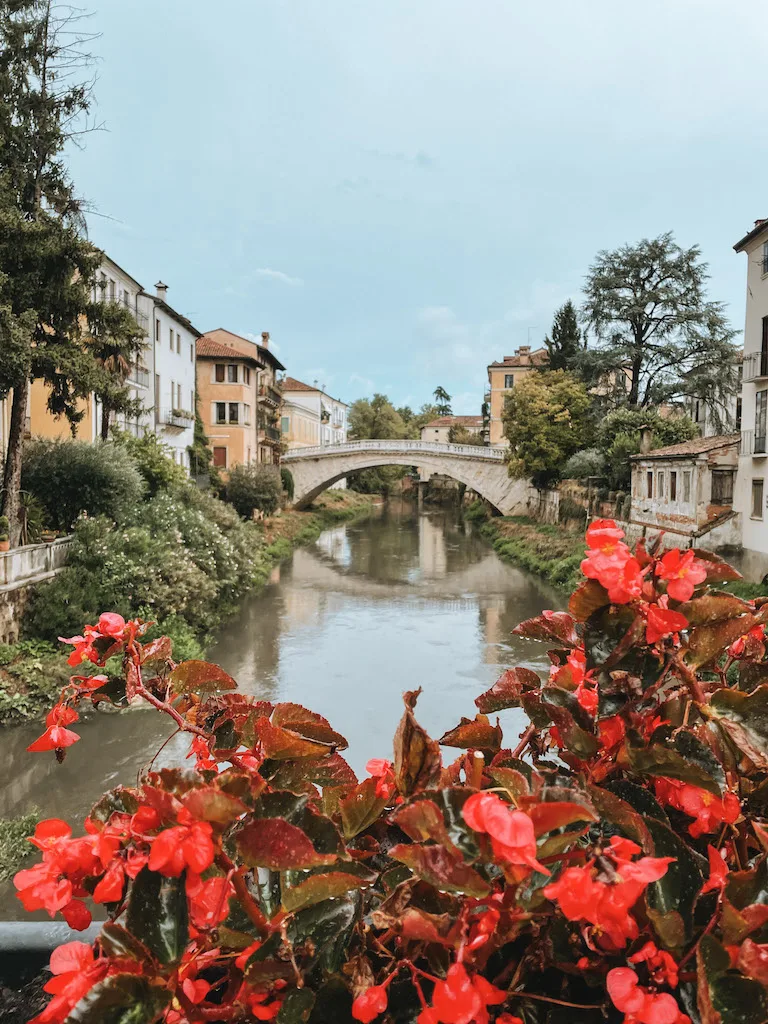
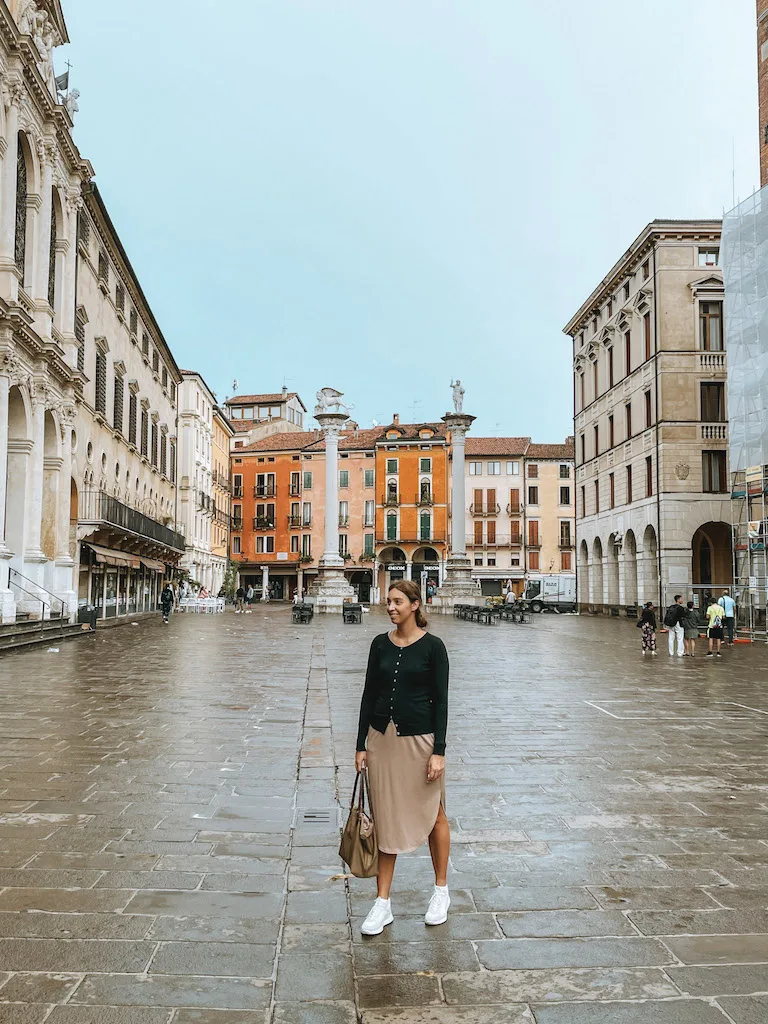
Besides the elegant, expertly designed buildings and Palladian villas, the city – which is listed as a UNESCO World Heritage Site – boasts a rich artistic heritage and delicious local cuisine.
The train journey from Padua to Vicenza takes slightly over 15 minutes, and tickets cost 4.70€, so there’s really no excuse not to go!
WHERE TO STAY IN PADUA
Staying in the city overnight? These are the best Padua hotels for all budgets.
BOUTIQUE HOTEL: Padova Suites C20 overlooks Piazza del Santo, offering phenomenal views from its spacious rooms. They all feature a private bathroom, a wardrobe, a kettle, and a minibar, and some even have a balcony. There is a restaurant on-site as well.
BOUTIQUE HOTEL: Officine Cavour Piazza Cavour has very trendy lofts equipped with a kitchen, dining furniture, a flat-screen TV, and a private bathroom with bathrobes and slippers. Bikes are rented on-site, and the property is conveniently located in the city center.
MID-RANGE HOTEL: B&B Casa Camilla is a charming home in a residential area of Padua that will make you feel like a local. With traditional décor and comfortable rooms, guests will have a private bathroom, modern amenities, and daily breakfast. Bike rental is available as well.
ON A BUDGET: Casa a Colori Padova offers double, triple, and family rooms with private bathrooms and a terrace or balcony. The property features a fitness center and a restaurant, and it serves an Italian or Continental breakfast.
BEST TIME TO VISIT PADUA
The best time of year to visit Padua is in the spring or the fall – the shoulder seasons. The weather from April to June and September is mild, and though there may be occasional rainy days, the temperature should be good enough to spend enjoyable days outdoors.
The summer months are a good alternative, but you have to account for very hot days, and it will also be the most crowded period.
